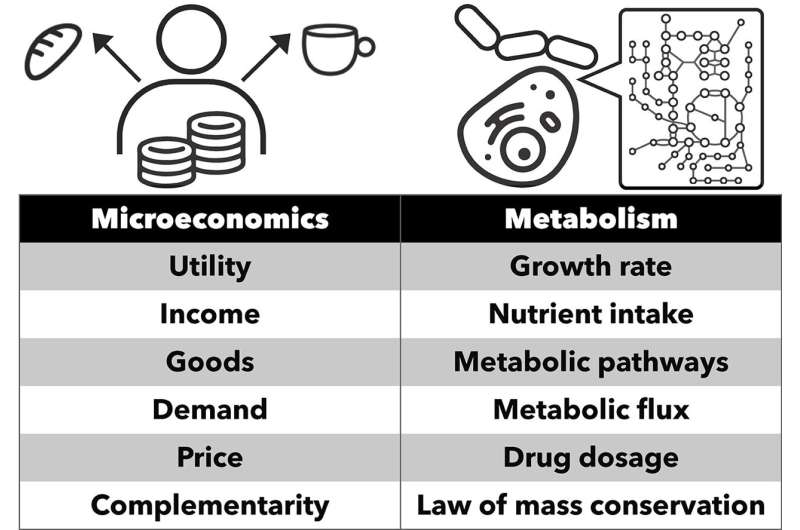This article has been reviewed according to Science X's editorial process and policies. Editors have highlighted the following attributes while ensuring the content's credibility:
fact-checked
peer-reviewed publication
trusted source
proofread
Researchers use microeconomics theory to predict how biological systems respond to environmental change

A team from the University of Tokyo has combined economic theory with biology to understand how natural systems respond to change. The researchers have published their findings in Physical Review Letters.
The researchers noticed a similarity between consumers' shopping behavior and the behavior of metabolic systems, which convert food into energy in our bodies. The team focused on predicting how different metabolic systems might respond to environmental change by using an economic tool called the Slutsky equation.
Their calculations indicated that very different metabolic systems actually share previously unknown universal properties, and can be understood using tools from other academic fields. Metabolic processes are used in drug development, bioengineering, food production and other industries, so being able to predict how such systems will respond to change can offer many benefits.
Where do you get your energy from? Perhaps a long night's sleep, or a good breakfast and some exercise? These activities can all help as they support a healthy metabolism, the chemical processes by which our bodies convert food and drink into energy. Understanding how individual metabolic reactions behave and predicting how they may change under different circumstances is a big challenge. There are thousands of different reactions which enable us to move, think, grow—in short, to live.
In recent years, it has become possible to predict some reactions through numerical simulations, but this requires large amounts of data. However, researchers at the University of Tokyo have derived previously unknown universal properties of metabolic systems by applying microeconomic theory to their data.
"Until this research, we thought that metabolic systems varied so much among species and cell types that there were no common properties among them," explained Assistant Professor Tetsuhiro Hatakeyama from the Graduate School of Arts and Sciences. "However, we were very excited to demonstrate that all metabolic systems have universal properties, and that these properties can be expressed by very simple laws."
According to the researchers, this theory does not require as much detailed background data to be collected as other methods. It can also be effectively applied whether you are trying to understand the behavior of all metabolic processes in a cell or focusing on just one part—say, for example, how much oxygen it is using.
Hatakeyama, a biophysicist, was looking at some metabolic system diagrams when he noticed a striking similarity to diagrams used in economics. This realization inspired him to try an interdisciplinary approach and apply economic theory, which he had briefly studied, to his biology research.
Along with co-author Jumpei Yamagishi, a graduate student in the same lab, he decided to explore how both consumers and cells optimize their "spending" to maximize gain: Whereas we as consumers spend money, cells "spend" nutrients. They reasoned if there were similarities in this way, then perhaps the same theories that are used to identify patterns in consumer behavior under changing financial situations could also identify patterns in cellular metabolic behavior under changing environments.
More specifically, the researchers focused on the Slutsky equation, which is used to understand changes in consumer demand. In particular, it is used to understand so-called Giffen goods, which counterintuitively go up in demand when the price increases and go down in demand when the price decreases.
According to Hatakeyama, this is similar to cellular metabolic behavior in response to a disturbance. For example, respiration demand (the Giffen goods in this case) in cancer cells goes up, counterintuitively, with increased drug dosage (the "price"), even though this is not beneficial to the growth rate of the cancer. The outcome was that the team uncovered a universal law for how metabolic systems respond to change.
One of the key benefits of this law is that it can be used to understand metabolic systems about which few details are known. "Disturbances in metabolic systems lead to a variety of diseases, and our research could be used to propose new treatment strategies for diseases for which treatments are not fully understood," said Hatakeyama.
"In addition, many foods and medicines are made using the metabolic systems of organisms. By applying the simple equation found in this study, we can know how to increase the output of products made with these systems." Hatakeyama hopes that through further interdisciplinary research, more universal laws might be discovered that will lead to a variety of useful applications.
More information: Linear Response Theory of Evolved Metabolic Systems, Physical Review Letters (2023). journals.aps.org/prl/abstract/ … ysRevLett.131.028401
Journal information: Physical Review Letters
Provided by University of Tokyo




















